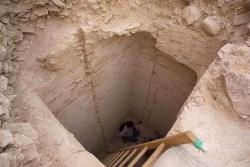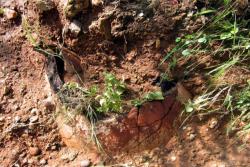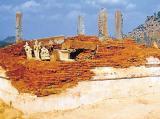INSTITUT SUPERIEUR D'ANTHROPOLOGIE
INSTITUTE OF ANTHROPOLOGY
ONLINE COURSES / COURS A DISTANCE
SPRING TERM : APRIL 2015
REGISTER NOW
EGYPTE –  Abousir - Des archéologues tchèques ont découvert en Egypte la tombe d'une reine jusqu'alors inconnue, «Khant Kaous III», épouse d'un pharaon de la Ve dynastie qui régna il y a quelque 4.500 ans, a annoncé dimanche le ministère égyptien des Antiquités. «Pour la première fois, nous découvrons le nom de cette reine qui était jusqu'alors inconnue avant la découverte de sa tombe,» a affirmé le ministre des Antiquités Mamdouh al-Damaty dans un communiqué. La tombe a été mise au jour au sud-ouest du Caire, sur le site d'Abou Sir, qui comprend plusieurs pyramides de pharaons de la Ve dynastie, qui régna sur la Haute Egypte quelque 2.500 ans avant Jésus-Christ. Cette découverte «va permettre de nous éclairer sur certains aspects inconnus de la Ve dynastie, qui avec la IVe dynastie a été témoin de la construction des premières pyramides», a précisé le ministre.
Abousir - Des archéologues tchèques ont découvert en Egypte la tombe d'une reine jusqu'alors inconnue, «Khant Kaous III», épouse d'un pharaon de la Ve dynastie qui régna il y a quelque 4.500 ans, a annoncé dimanche le ministère égyptien des Antiquités. «Pour la première fois, nous découvrons le nom de cette reine qui était jusqu'alors inconnue avant la découverte de sa tombe,» a affirmé le ministre des Antiquités Mamdouh al-Damaty dans un communiqué. La tombe a été mise au jour au sud-ouest du Caire, sur le site d'Abou Sir, qui comprend plusieurs pyramides de pharaons de la Ve dynastie, qui régna sur la Haute Egypte quelque 2.500 ans avant Jésus-Christ. Cette découverte «va permettre de nous éclairer sur certains aspects inconnus de la Ve dynastie, qui avec la IVe dynastie a été témoin de la construction des premières pyramides», a précisé le ministre.
La tombe daterait du milieu de la Ve dynastie (2494-2345 av.JC), selon un responsable du ministère. La tombe a été découverte sur le site du complexe funéraire de Néferefrê, pharaon de la Ve dynastie, a indiqué le directeur de la mission archéologique tchèque, Miroslav Barta, précisant que «cela laisse à penser que la reine était la femme de Néferefrê.» Les archéologues y ont trouvé des ustensiles de la vie quotidienne, 24 en calcaires et quatre autres en cuivre, ainsi que des inscriptions murales faites par les ouvriers de la tombe, comprenant notamment le nom et les titres de la reine, selon le communiqué.
https://fr.news.yahoo.com/tombe-dune-reine-pharaonique-d%C3%A9couverte-egypte-144701763.html
INDE –  Thandigudi - Several urns in which bodies of the dead were interred in ancient times by tribal people on Thandigudi hill surfaced on the bed of a forest stream near Marudha Nadhi dam at Iyyampalayam in the district owing to heavy flood on Friday. Portions of the urns were seen above the surface of the stream bed. At some places, urns were found in clusters near Sattiparai area. While three or four urns were found in a particular spot, several others were found scattered all over. Almost all the urns were in damaged condition. The tribal people might have buried these urns on the bank of the stream. Heavy flood in the stream created soil erosion bringing the urns to the surface, said a farmer, Ravi. Remains of these urns are proof to the presence of tribal people near Sattiparai near Thandigudi hill and their regular movement to Marudha Nadhi dam. Already, several archaeologists and researchers have conducted research in Thandigudi hills about tribal people and their culture and tradition. Meanwhile, some people, who believed that there could be hidden treasure, started digging the places where the urns were buried. They found only pieces of bones in the urns, Mr. Ravi said. Local people informed that these urns were present on a stretch of one km of the forest stream.
Thandigudi - Several urns in which bodies of the dead were interred in ancient times by tribal people on Thandigudi hill surfaced on the bed of a forest stream near Marudha Nadhi dam at Iyyampalayam in the district owing to heavy flood on Friday. Portions of the urns were seen above the surface of the stream bed. At some places, urns were found in clusters near Sattiparai area. While three or four urns were found in a particular spot, several others were found scattered all over. Almost all the urns were in damaged condition. The tribal people might have buried these urns on the bank of the stream. Heavy flood in the stream created soil erosion bringing the urns to the surface, said a farmer, Ravi. Remains of these urns are proof to the presence of tribal people near Sattiparai near Thandigudi hill and their regular movement to Marudha Nadhi dam. Already, several archaeologists and researchers have conducted research in Thandigudi hills about tribal people and their culture and tradition. Meanwhile, some people, who believed that there could be hidden treasure, started digging the places where the urns were buried. They found only pieces of bones in the urns, Mr. Ravi said. Local people informed that these urns were present on a stretch of one km of the forest stream.
http://www.thehindu.com/news/cities/Madurai/urns-surface-on-stream-bed-in-dindigul-district/article6753394.ece?
INDE –  Arethippuru - A Jain Basadi, built during Ganga dynasty in the sixth century, has been excavated near Arethippuru village, Maddur taluk, Mandya district. In the month of September and October, a team of more than 30 archeologists lead by T M Keshava, Deputy Superintending Archaeologist of Archeological Survey of India (ASI) and Assistant Archaeologist Aravali, had taken up the excavation works.A Jain temple, measuring about hundred feet in length and 40 feet in width was discovered, along with seven statues atop Chandragiri Hill. The jain temple consists of a facade, an entrance and sanctum sanctorum. Ten stone pillars, statues of Bahubali, Yaksha and Yakshini, have been excavated. Apart from them, several other relics that were used to peform rituals at the temple were also discovered during the excavation.Experts opine that the Basadi was dedicated to one of the Thirtankaras of Jainism and was once a popular place for pilgrims, along with the temples at Shravanabelagola.Following the retirement of Keshava, T Arun Raj has been appointed as the superintendent of the excavation project. However, the works have been temporarily discontinued. Aravali said that there were chances that four more Jain temples are present around the excavation site. “We will get more information once excavation is continued,” he said.
Arethippuru - A Jain Basadi, built during Ganga dynasty in the sixth century, has been excavated near Arethippuru village, Maddur taluk, Mandya district. In the month of September and October, a team of more than 30 archeologists lead by T M Keshava, Deputy Superintending Archaeologist of Archeological Survey of India (ASI) and Assistant Archaeologist Aravali, had taken up the excavation works.A Jain temple, measuring about hundred feet in length and 40 feet in width was discovered, along with seven statues atop Chandragiri Hill. The jain temple consists of a facade, an entrance and sanctum sanctorum. Ten stone pillars, statues of Bahubali, Yaksha and Yakshini, have been excavated. Apart from them, several other relics that were used to peform rituals at the temple were also discovered during the excavation.Experts opine that the Basadi was dedicated to one of the Thirtankaras of Jainism and was once a popular place for pilgrims, along with the temples at Shravanabelagola.Following the retirement of Keshava, T Arun Raj has been appointed as the superintendent of the excavation project. However, the works have been temporarily discontinued. Aravali said that there were chances that four more Jain temples are present around the excavation site. “We will get more information once excavation is continued,” he said.
http://www.deccanherald.com/content/451397/jain-temple-ganga-period-excavated.html?
IRAQ –  Ninive - The Islamic State (ISIS/ISIL) set their eyes on another historical site to demolish as they continue to establish their caliphate across Iraq. Residents near Mosul told Assyrian website Ankawa the militants’ plan to blow up the walls of Nineveh, which date back to almost 700 B.C. Unnamed sources said the Islamic State leaders told members to set booby traps along the walls. If the Iraqi army attempts to liberate the area, the militants must “complete the bombing of the historic walls.” The walls are attributed to King Sennacherib, who rebuilt the city during his reign beginning in 704 B.C., and consist of a seven and a half mile barrier around the city—presumably to protect it from attack when it served as the capital of ancient Assyria. Nineveh was so important and Sennacherib’s contributions so great that some archaeologists have gone as far as to attribute to him the construction and maintenance of the ancient Hanging Gardens, long believed to be in Babylon. The Islamic State moved to the Nineveh Plain in early August, “the last stronghold of Assyrians in Iraq.” Over 200,000 Assyrians fled to the Dohuk and Arbel areas.
Ninive - The Islamic State (ISIS/ISIL) set their eyes on another historical site to demolish as they continue to establish their caliphate across Iraq. Residents near Mosul told Assyrian website Ankawa the militants’ plan to blow up the walls of Nineveh, which date back to almost 700 B.C. Unnamed sources said the Islamic State leaders told members to set booby traps along the walls. If the Iraqi army attempts to liberate the area, the militants must “complete the bombing of the historic walls.” The walls are attributed to King Sennacherib, who rebuilt the city during his reign beginning in 704 B.C., and consist of a seven and a half mile barrier around the city—presumably to protect it from attack when it served as the capital of ancient Assyria. Nineveh was so important and Sennacherib’s contributions so great that some archaeologists have gone as far as to attribute to him the construction and maintenance of the ancient Hanging Gardens, long believed to be in Babylon. The Islamic State moved to the Nineveh Plain in early August, “the last stronghold of Assyrians in Iraq.” Over 200,000 Assyrians fled to the Dohuk and Arbel areas.
http://www.breitbart.com/national-security/2015/01/02/isis-targets-2000-year-old-ancient-nineveh-walls-in-iraq/?